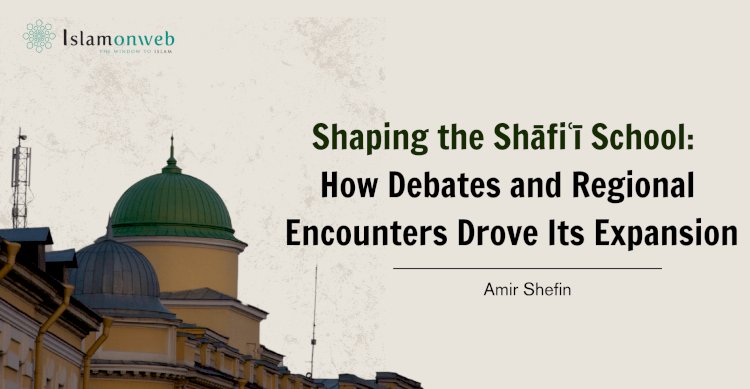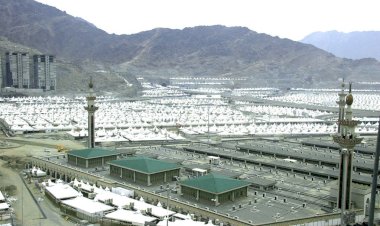Shaping the Shāfiʿī School: How Debates and Regional Encounters Drove Its Expansion
Echoing the view of the classical Ḥanbalī scholar Ibn Qudāmah al-Maqdisī, it is widely accepted that the divergence among Muslim jurists is, in fact, a manifestation of divine mercy for the ummah[1]. Islamic intellectual history bears witness to this plurality, with scholarly debates and encounters forming a core part of the tradition. Rather than representing a static or monolithic legal system, Islamic jurisprudence has long thrived as a dynamic, discursive tradition.
These debates varied in nature—some were shaped by geographical contexts, while others distinguished themselves by their methodological rigor and organizational frameworks. Personal dynamics were not excluded; in fact, some debates evolved into individual rivalries, and in rare cases, even led to public confrontations—scenes not uncommon in the turbulent yet fertile history of Islamic legal development. Mahmood Kooria, in his work Islamic Law in Circulation, notes such moments as inevitable by-products of a vibrant and contested intellectual space[2].
This article aims to explore how these encounters and debates functioned as indispensable mechanisms in the shaping and dissemination of the Shāfiʿī school of jurisprudence.
Methodological Diversion
One of the earliest phases of intra-school debate within the Shāfiʿī tradition arose from methodological divergences between two of Imām al-Shāfiʿī’s most distinguished disciples: al-Buwayṭī and al-Muzanī. Both scholars authored works rooted in Kitāb al-Umm, the foundational compendium of their teacher. However, their respective approaches to jurisprudence showcased markedly different styles of legal reasoning and hermeneutics.
Al-Buwayṭī, influenced by the traditionalist inclinations of Imām Mālik, maintained a conservative interpretive framework that emphasised transmitted reports (naql) and precedent. In contrast, al-Muzanī adopted a more rationalistic orientation, drawing from the analytical methods of Imām Abū Ḥanīfah, thus engaging with reason (raʾy) and structured logic more openly.
Residing in Baghdad during the Abbasid era, al-Buwayṭī demonstrated exceptional skill in issuing fatāwā. His reputation was such that Abū ʿĀṣim al-Ibādī, a Shāfiʿī jurist, noted: “Imām al-Shāfiʿī often relied on al-Buwayṭī for issuing legal verdicts; thanks to his unwavering competence, he was regarded as the rightful successor to the Imām.”[3] Yet, his unwavering theological stance—particularly his rejection of the Muʿtazilī doctrine of the Khalq al-Qurʾān (createdness of the Qurʾān)—led to his imprisonment and eventual martyrdom under Abbasid persecution. He died in custody in the year 231 AH. His contributions were later praised by Imām Tāj al-Dīn al-Subkī in Ṭabaqāt al-Shāfiʿiyyah, who celebrated the distinct excellence of his scholarship.
On the other hand, Imām al-Muzanī, while still grounded in tradition, did not shy away from employing rational tools in legal analysis. His intellectual sharpness was acknowledged by Imām al-Shāfiʿī himself, who once remarked, when surrounded by his disciples al-Buwayṭī, al-Rabīʿ, and al-Muzanī: “Undoubtedly, al-Muzanī could have surpassed all had he debated with Shayṭān.”[4] This statement not only highlights his brilliance but also the confidence his teacher placed in his reasoning abilities.
Al-Muzanī’s most influential work, Mukhtaṣar al-Muzanī, took him twenty years to complete. It is reported that he revised the text eight times, each time preparing with three days of fasting and continuous prayer—an act reflecting both scholarly rigour and spiritual devotion.
As mentioned earlier, beyond personal rivalries or interpersonal tensions, these methodological divergences significantly contributed to the intellectual expansion of the Shāfiʿī school. Each approach—traditionalist and rationalist—captivated its own audience, enriching the school’s diversity and appeal. Ultimately, however, it was Mukhtaṣar al-Muzanī, with its rationalist edge, that gained greater circulation and influence within Shāfiʿī circles, shaping legal discourse across generations.
Geographical Division
The methodological divergence between al-Buwayṭī and al-Muzanī gradually subsided, giving way to a broader sectarian distinction based on geographical lines—namely, between the jurists of Iraq and Khurāsān. Though these two factions shared a common adherence to the Shāfiʿī school, their interpretive tendencies differed significantly. Despite being acknowledged in classical texts, the distinctiveness of these regional strands has often been overlooked in modern scholarship.
The Iraqi Shāfiʿīs exhibited a more cautious and tradition-oriented approach, favouring strict adherence to the statements of earlier jurists within the school and demonstrating restraint in analogical reasoning (qiyās). In contrast, Khurāsānī scholars displayed a pronounced inclination towards rationalism, with their texts often distinguished by their analytical depth and refined organisational structure.
When it came to reliability in transmitting Imām al-Shāfiʿī’s legal opinions, Imām al-Nawawī offered a critical assessment. In his al-Majmūʿ, he stated that the Iraqi jurists were generally more dependable in accurately conveying the Imām’s juridical statements, especially when it came to choosing between conflicting views attributed to him.
Among the prominent figures and foundational texts of these respective regional traditions were Imām al-Shīrāzī, author of al-Muhadhdhab, and Imām al-Ghazālī, author of al-Wasīṭ. While the former incorporated theological elements to support jurisprudential rulings, the latter sought to rationalise legal concepts through a more philosophical lens.
Notable Khurāsānī texts from the later period include al-Tatimmat, al-Nihāyah, and al-Tahdhīb. In these works, the reference to "al-Qāḍī" typically denotes Qāḍī Ḥusayn, a leading figure in the Khurāsānī tradition. Conversely, among the Iraqis, the equivalent scholarly authority was Abū Ḥāmid al-Marwazī.
This regional schism within the Shāfiʿī school eventually found resolution through the work of Imām al-Nawawī. In his legal compendium Minhāj al-Ṭālibīn, he synthesised the viewpoints of both traditions, effectively harmonising the rationalist precision of Khurāsān with the traditionalist fidelity of Iraq. His work became a cornerstone for later Shāfiʿī legal thought, bridging the divide and preserving the richness of both legacies.
City-Oriented Encounters
Imām al-Nawawī’s engagement in textual disputes—culminating in the compilation of Minhāj al-Ṭālibīn—marked the beginning of a new phase in the Shāfiʿī school, characterised by city-based scholarly traditions centred in Makkah and Cairo, two pivotal cities in the Islamic world. These centres gave rise to distinctive interpretive trends as scholars began to comment on Minhāj using different methodological lenses, deepening the intellectual landscape of Shāfiʿī jurisprudence.
In Makkah, this scholarly movement was led by the renowned jurist Ibn Ḥajar al-Haythamī (d. 1567 CE), who authored the influential Tuḥfat al-Muḥtāj fī Sharḥ al-Minhāj. Born in 1504 CE in Abū Haytham, located in present-day Western Egypt, Ibn Ḥajar emerged as a towering figure in Shāfiʿī legal thought. Among his many contributions was the development of a novel juristic framework known as al-Furūq al-Fiqhiyyah—a method of categorising legal rulings based on nuanced distinctions in underlying principles.
Cairo, meanwhile, witnessed a parallel intellectual rise led by Imām Shams al-Dīn al-Ramlī (d. 1596 CE), a colleague of Ibn Ḥajar at the prestigious al-Azhar University. Often referred to as al-Shāfiʿī al-Ṣaghīr (“the Little Shāfiʿī”), al-Ramlī’s rigorous contributions significantly shaped the interpretive methods of the school. Appointed at a young age to issue fatāwā for the Shāfiʿī school, he also preserved and extended the work of his father, Imām Shihāb al-Dīn al-Ramlī.
Among his major works are Nihāyat al-Muḥtāj, a commentary on Minhāj, as well as Ghāyat al-Bayān fī Sharḥ Zubad Ibn Raslān, ʿUmdat al-Rābiḥ fī Maʿrifat al-Ṭarīq al-Wāḍiḥ, Sharḥ Matn Hādyat al-Nāṣih, and Ḥāshiyat al-Ramlī. These texts stand as lasting testaments to his mastery not only in jurisprudence but also in broader Islamic disciplines.
Though there existed a pronounced methodological divergence between the Makkah and Cairo schools, the scholarly partnership between Ibn Ḥajar and al-Ramlī signalled a flourishing era in the Shāfiʿī madhhab. Alongside them, other towering scholars—Imām Shihāb al-Dīn al-Ramlī, Abū Zakariyyā al-Anṣārī, and al-Khaṭīb al-Shirbīnī—played key roles in shaping the transmission and reception of Shāfiʿī texts across the Muslim world. Collectively, these five scholars became known as ʿUlamāʾ al-Khamsa (“The Five Scholars”).
In recognition of their foundational contributions, the period in which they lived came to be designated as the Era of the Confirmers (ʿAṣr al-Muqarrirīn). This epoch was defined by the scholars’ collective efforts to consolidate, clarify, and expand upon the doctrines of Imām al-Shāfiʿī. Their scholarly output safeguarded the coherence of the madhhab and ensured its adaptability amidst evolving jurisprudential and societal challenges. The term “Confirmers” aptly captures their mission of reaffirming the school’s core principles while refining its legacy.
Noteworthy works from this era include al-Anṣārī’s Minḥāl al-Ṭullāb fī Fiqh al-Imām al-Shāfiʿī, Taḥrīr Tanqīḥ al-Lubāb fī Fiqh al-Imām al-Shāfiʿī, and Nihāyat al-Hidāyah ilā Taḥrīr al-Kifāyah, as well as al-Shirbīnī’s al-Iqnāʿ and Mughnī al-Muḥtāj. These texts reflect a rich scholarly tradition dedicated to both preservation and renewal.
About the author
Amir Shefin is a dedicated lecturer at Darul Irshad, MIC, located in Chattanchal, Kerala.
Reference
[1] Mughni, Ibn Qudama
[2] Kooria, Mahmood, Islamic Law in Circulation
[3]https://ar.m.wikipedia.org/wiki/%D9%8A%D9%88%D8%B3%D9%81_%D8%A8%D9%86_%D9%8A%D8%AD%D9%8A%D9%89_%D8%A7%D9%84%D8%A8%D9%88%D9%8A%D8%B7%D9%8A
[4] Baihaqi, Manaqib Al Shafi’
Disclaimer
The views expressed in this article are the author’s own and do not necessarily mirror Islamonweb’s editorial stance.
























Leave A Comment